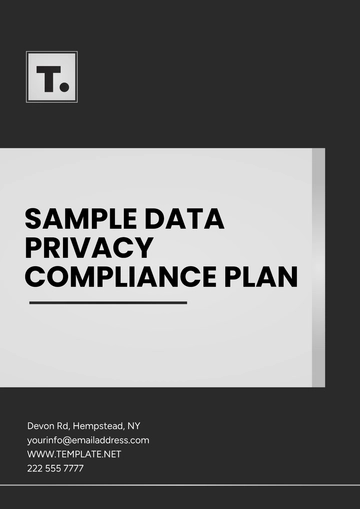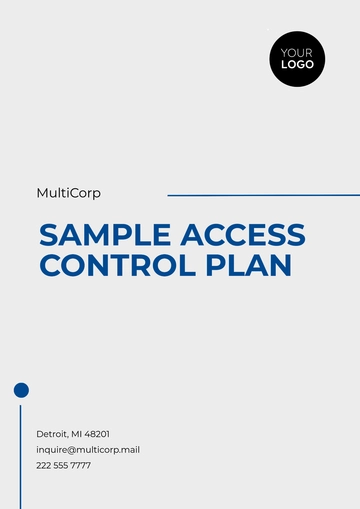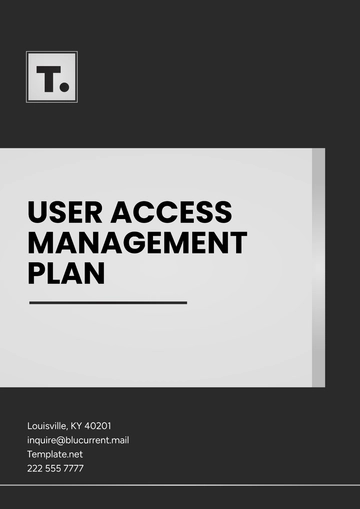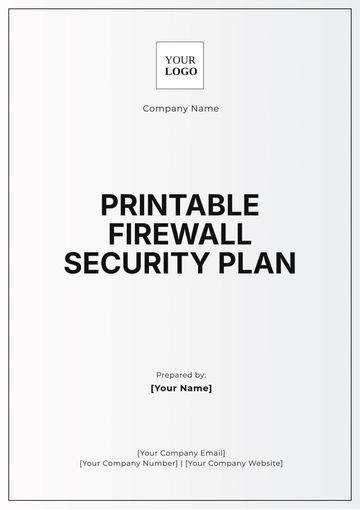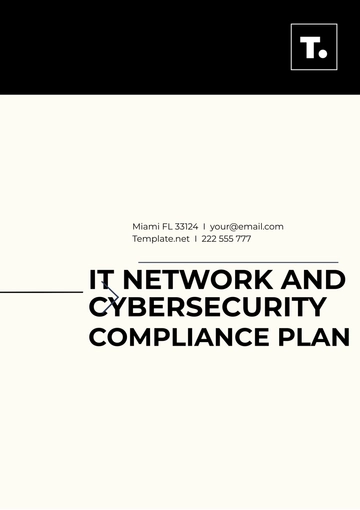Free IT Network And Cybersecurity Compliance Plan
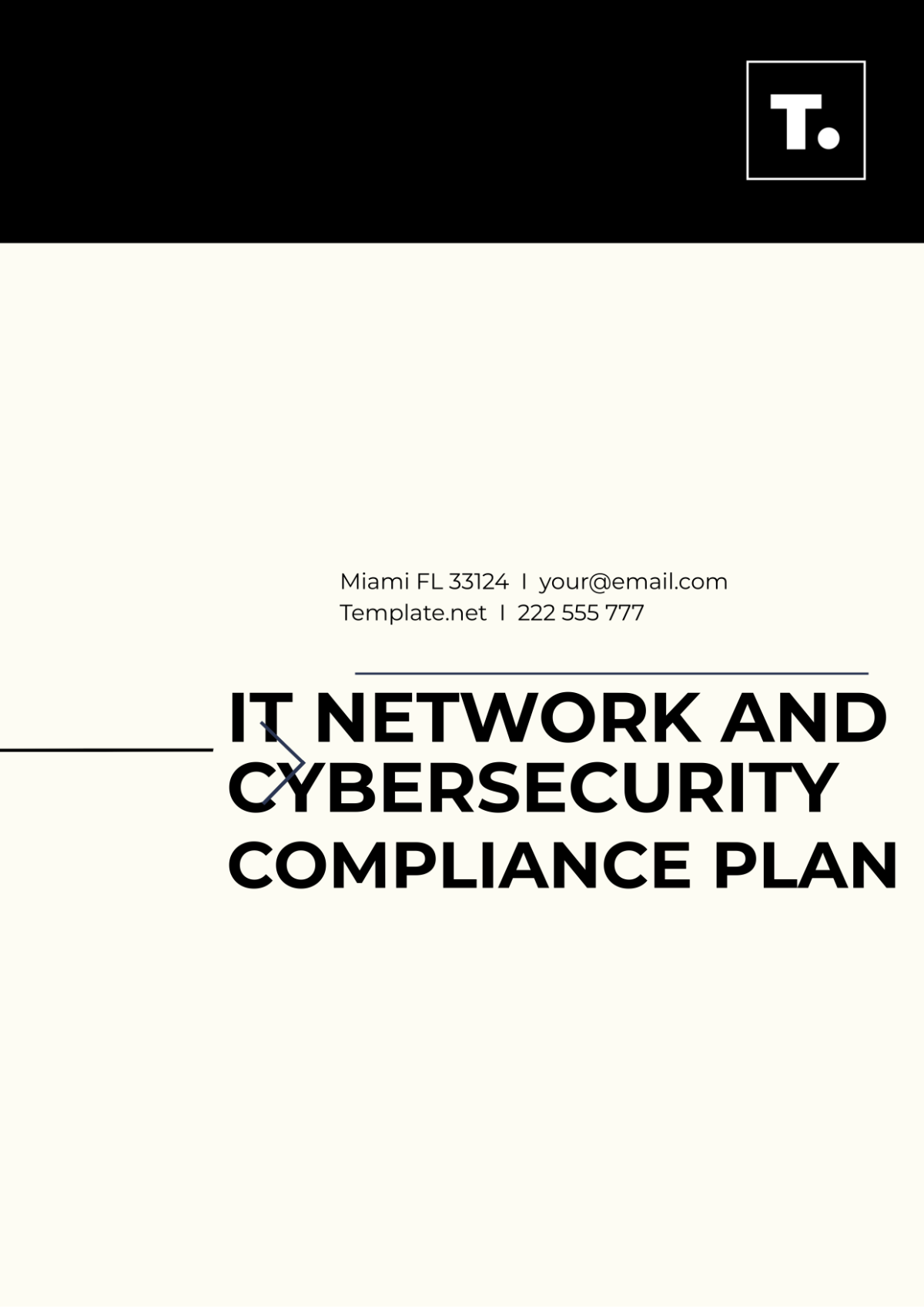
1. Introduction
[Your Company Name] commitment to IT network and cybersecurity compliance.
Purpose: The purpose of this compliance plan is to establish and maintain a robust IT network and cybersecurity practices to protect sensitive data, ensure business continuity, and comply with regulatory requirements.
Scope: This compliance plan encompasses all aspects of IT network and cybersecurity within Acme Technologies Inc., including policies, procedures, risk management, training, vendor management, monitoring, and reporting. It applies to all employees, contractors, and third-party vendors who interact with the organization's IT systems and data.
2. Governance and Leadership
Appointment of [Your Name] as the Chief Compliance Officer.
Establishment of a Compliance Committee comprising representatives from IT, legal, and senior management.
Documentation of roles and responsibilities.
3. Regulatory Compliance
Compliance with relevant laws and regulations such as GDPR, HIPAA, PCI DSS, etc.
Regular monitoring for updates and changes in regulations.
Documentation of compliance efforts and audits.
4. Risk Management
Identification of IT network and cybersecurity risks.
Assessment of potential impacts and likelihood of occurrence.
Implementation of risk mitigation strategies such as regular security
assessments and penetration testing.
5. Policies and Procedures
5.1. Access Control
Enforcement of strong password policies with regular expiration and complexity requirements.
Regular review and update of user access privileges based on job roles.
Implementation of multi-factor authentication for remote access and critical systems.
5.2. Data Protection
Encryption of sensitive data in transit and at rest using industry-standard encryption algorithms.
Regular backups and testing of data recovery procedures to ensure data integrity.
Compliance with data retention policies as outlined in the organization's data management guidelines.
5.3. Network Security
Implementation of firewalls and intrusion detection systems to monitor and protect the network perimeter.
Regular vulnerability assessments and patch management to address security vulnerabilities promptly.
Monitoring of network traffic for suspicious activities using intrusion detection and prevention systems.
5.4. Incident Response
Development of an incident response plan outlining roles, responsibilities, and escalation procedures.
Training of staff on identifying and reporting security incidents promptly to the IT security team.
Documentation and review of incident response procedures following each security incident or breach.
6. Training and Awareness
Provision of regular cybersecurity training for all employees covering topics such as phishing awareness, password security, and social engineering.
Awareness campaigns on phishing and social engineering threats through emails, posters, and internal communications.
Testing of employee awareness through simulated phishing exercises conducted quarterly.
7. Vendor Management
Due diligence of third-party vendors regarding their cybersecurity practices before engaging in any business relationship.
Inclusion of cybersecurity requirements in vendor contracts, including clauses for data protection and breach notification.
Regular assessment of vendor compliance through security assessments and audits.
8. Monitoring and Auditing
Continuous monitoring of IT systems for security breaches using a combination of automated tools and manual checks.
Regular internal audits of IT networks and cybersecurity controls are conducted annually by the internal audit team.
External audits by third-party firms to validate compliance efforts and provide independent assessments of the organization's security posture.
9. Documentation and Reporting
Maintenance of detailed documentation of compliance efforts, including policies, procedures, assessments, and audit reports.
Reporting of compliance status to the Executive Management and Regulatory Authorities quarterly or as required by regulations.
Documentation of corrective actions taken in response to non-compliance issues identified during audits or assessments.
10. Continual Improvement
Regular review and update of the compliance plan based on changes in regulations, technology, and business requirements.
Feedback mechanisms for employees to suggest improvements to existing policies and procedures.
Participation in industry forums and conferences to stay updated on emerging threats, trends, and best practices in cybersecurity.
11. Signature
I certify that I have reviewed and approved this IT Network And Cybersecurity Compliance Plan. By signing below, I commit to upholding its policies and ensuring compliance with cybersecurity standards.

[Your Name]
Chief Compliance Officer
Date: [Date]
- 100% Customizable, free editor
- Access 1 Million+ Templates, photo’s & graphics
- Download or share as a template
- Click and replace photos, graphics, text, backgrounds
- Resize, crop, AI write & more
- Access advanced editor
Discover the ultimate solution for IT network and cybersecurity compliance with Template.net's meticulously crafted template. Effortlessly meet regulatory standards with this fully editable and customizable plan. Tailor it to your specific needs using our AI Editor Tool, ensuring seamless integration into your organization's framework. Simplify compliance while fortifying your digital infrastructure with confidence.
You may also like
- Finance Plan
- Construction Plan
- Sales Plan
- Development Plan
- Career Plan
- Budget Plan
- HR Plan
- Education Plan
- Transition Plan
- Work Plan
- Training Plan
- Communication Plan
- Operation Plan
- Health And Safety Plan
- Strategy Plan
- Professional Development Plan
- Advertising Plan
- Risk Management Plan
- Restaurant Plan
- School Plan
- Nursing Home Patient Care Plan
- Nursing Care Plan
- Plan Event
- Startup Plan
- Social Media Plan
- Staffing Plan
- Annual Plan
- Content Plan
- Payment Plan
- Implementation Plan
- Hotel Plan
- Workout Plan
- Accounting Plan
- Campaign Plan
- Essay Plan
- 30 60 90 Day Plan
- Research Plan
- Recruitment Plan
- 90 Day Plan
- Quarterly Plan
- Emergency Plan
- 5 Year Plan
- Gym Plan
- Personal Plan
- IT and Software Plan
- Treatment Plan
- Real Estate Plan
- Law Firm Plan
- Healthcare Plan
- Improvement Plan
- Media Plan
- 5 Year Business Plan
- Learning Plan
- Marketing Campaign Plan
- Travel Agency Plan
- Cleaning Services Plan
- Interior Design Plan
- Performance Plan
- PR Plan
- Birth Plan
- Life Plan
- SEO Plan
- Disaster Recovery Plan
- Continuity Plan
- Launch Plan
- Legal Plan
- Behavior Plan
- Performance Improvement Plan
- Salon Plan
- Security Plan
- Security Management Plan
- Employee Development Plan
- Quality Plan
- Service Improvement Plan
- Growth Plan
- Incident Response Plan
- Basketball Plan
- Emergency Action Plan
- Product Launch Plan
- Spa Plan
- Employee Training Plan
- Data Analysis Plan
- Employee Action Plan
- Territory Plan
- Audit Plan
- Classroom Plan
- Activity Plan
- Parenting Plan
- Care Plan
- Project Execution Plan
- Exercise Plan
- Internship Plan
- Software Development Plan
- Continuous Improvement Plan
- Leave Plan
- 90 Day Sales Plan
- Advertising Agency Plan
- Employee Transition Plan
- Smart Action Plan
- Workplace Safety Plan
- Behavior Change Plan
- Contingency Plan
- Continuity of Operations Plan
- Health Plan
- Quality Control Plan
- Self Plan
- Sports Development Plan
- Change Management Plan
- Ecommerce Plan
- Personal Financial Plan
- Process Improvement Plan
- 30-60-90 Day Sales Plan
- Crisis Management Plan
- Engagement Plan
- Execution Plan
- Pandemic Plan
- Quality Assurance Plan
- Service Continuity Plan
- Agile Project Plan
- Fundraising Plan
- Job Transition Plan
- Asset Maintenance Plan
- Maintenance Plan
- Software Test Plan
- Staff Training and Development Plan
- 3 Year Plan
- Brand Activation Plan
- Release Plan
- Resource Plan
- Risk Mitigation Plan
- Teacher Plan
- 30 60 90 Day Plan for New Manager
- Food Safety Plan
- Food Truck Plan
- Hiring Plan
- Quality Management Plan
- Wellness Plan
- Behavior Intervention Plan
- Bonus Plan
- Investment Plan
- Maternity Leave Plan
- Pandemic Response Plan
- Succession Planning
- Coaching Plan
- Configuration Management Plan
- Remote Work Plan
- Self Care Plan
- Teaching Plan
- 100-Day Plan
- HACCP Plan
- Student Plan
- Sustainability Plan
- 30 60 90 Day Plan for Interview
- Access Plan
- Site Specific Safety Plan
